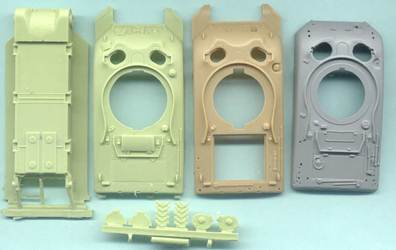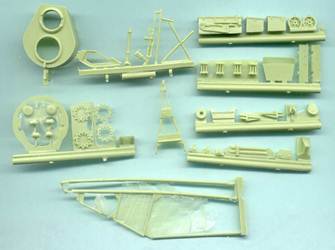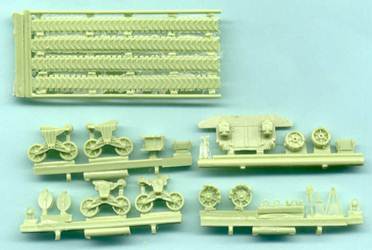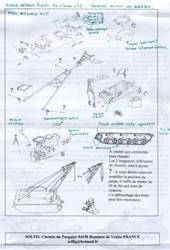|
Preliminary notes:
- This kit represents a Sherman M32B1.
- The history of "Retrokit" is quite confusing, but after
having checked with the current owner of Retrokit, it seems that this
kit is no longer part of the Retrokit line. Instead it can be found
under the Solfig label. To confuse matters even further, it was previously
sold under the Exokit label.
For Sherman
fans this kit should be on your to-do list: an armored recovery vehicle
based on the M4 Medium tank of WW2 and the Korean War. The subject
of this model and review is the M32B1 based on the cast hull M4A1
Sherman. This is a full all-resin model kit, not a conversion.
History
for the Modeler
In 1943, the T5 armored recovery vehicle (ARV) based on the M4 series
of medium tanks was put into production to replace the M31 ARV which
was based on the M3 Lee and grant medium tanks. Between 1943 and June
1945 the M4 Sherman conversion became the M32, the M4A1 the M32B1,
the M4A2 became the M32B2, and the M4A3 conversion became the M32B3.
I have also seen this referred to as a TRV, for Tank Recovery Vehicle.
The M32 lacked the rotating turret and main gun of the Sherman tank
which was replaced by a fixed turret, an A-frame crane, 50-calibre
AA machine gun (MG) and an 81-mm mortar mounted on the glacis for
launching smoke bombs.
-
Retrokit’s M32, like their other model kits, come in Ziploc
plastic bags within a sturdy cardboard box. The box top above shows
a small photo of an M32B1 in travel mode, with the crane folded
back.
- I
cannot see a lot of detail but we can make out the VVSS suspension
and a spare dish-style roadwheel mounted on the rear corner.
- The
vehicle appears finished in a monotone color that I think we can
safely presume to be olive drab, and there is a single white star
on the turret and something which looks like white markings on the
hull side. The tracks appear to be the all steel T-54E1 type with
chevrons.
The
Parts
I counted about 80 pale green, cast resin, parts. Molding and detail
quality appears very good and typical of Retrokit models. Separating
the parts from the pour plugs does not look too hard with a sharp
blade, file and saw. There is a little thin flash around some parts
but only a few small airbubbles.
-

Above is a photo of the hull parts at left with hulls from the old
ESCI (now Italeri) M4A1 kit in the center and the Dragon late M4A1
kit in gray plastic at far right. Based on my knowledge of the ESCI
and Dragon kit, the model is pretty close to 1/72 in scale.
- To
me it’s obvious that Retrokit based their M32 on the venerable
ESCI M4A1 hull which means it comes with many of the problems, or
issues, of the ESCI kit. Some of these issues are: fuel caps too
small, right-rear roof vent too small, the hood-like bulges in front
of the driver’s hatches appear a little over-exaggerated to
me, and the tear-drop shaped grouser-compartment covers at the rear
corners are too small. Also, since this vehicle does not use the
storage shelf at the rear top edge, the three small notches there
should be filled with putty and sanded level.
- All
but one of the WW2 and Korea reference photos for the M32B1 I have
show this ARV based on the small hatch M4A1 tank, but we can see
that this model kit is based on the big-hatch M4A1 meaning that
it is a late WW2 version. Therefore we should not portray it in
a diorama before June 1944 perhaps.
- At
the bottom of the photo are the vehicle hull and turret hatches
and some short runs of T-54E1 all-steel track.

This scan displays many of the parts associated with the ARV. At
upper left is the fixed, hollow turret with two hatches on top,
one of which has a split hatch cover common of early and mid-production
Sherman turrets. The forward, larger opening has no hatch cover
and is the hatch where a 50-cal. MG could be mounted. - Below
the turret is the pour plug with the turret floor with what appear
to me to be crew seats and parts associated with the crane. On the
same pour block are four spare sprocket wheels that mount on the
turret side.
- In
the upper center are parts for the crane, the 81-mm mortar, what
looks like a 50-cal. MG. At upper right are the storage boxes and
spare roadwheels that mount on the engine deck area.
- At
the very bottom are the long crane arms that will need some straitening
in hot water. Considering how fragile these could be on the finished
model, it may be wise to replace them with brass tubing.
-

This last scan of the kit parts show the track lengths which
look to me to represent T-54E1 all steel track. (Not all of the
kit parts are included in these scans.)
- Below
are the pour plugs with the one-piece vertical volute spring suspension
bogies and various kit parts. The bogies have the solid six spoke
roadwheels from the ESCI (Italeri) M4A1 kit. The area under the
track skid at the top of the bogie is solid, which is too bad; for
a contest model we could saw this off and replace it with etched
brass skids from a UM kit or from a number of etched brass frets
available.
- The
sprocket and read idler wheel have the track links molded onto them,
which I appreciate.
-

Retrokit’s assembly instruction for their M32 is a black
& white, exploded-view type with instructions and vehicle history
in French on the other side. The level of detail shown in the instructions
is very good, better than most resin kit manufacturers.
- The
instructions come on a 46 x 32-cm sheet of paper but considering
the complexity of assembly I find the instructions too small. The
drawings are a bit faint as well, perhaps from being photocopied
too often? They should be enlarged to cover two sides of paper.
- There
is no parts diagram and parts are not numbered on the pour plugs
or on the instructions so some smaller parts may be hard to identify.
This is a common problem with small-scale resin models. Study your
references well! Studying models of the M32 in that other larger
and less challenging scale may also be helpful.
Conclusions
- I
feel this is a great kit, because it’s a unique vehicle that
I’ve not seen done in 1/72 by others, and because it is very
well done.
- The
ARV parts like the crane and storage boxes, etc. should be easy
to build on another manufacturer’s Sherman (UM, Dragon, Trumpeter,
MR etc.) to create other M32 versions.
References
|